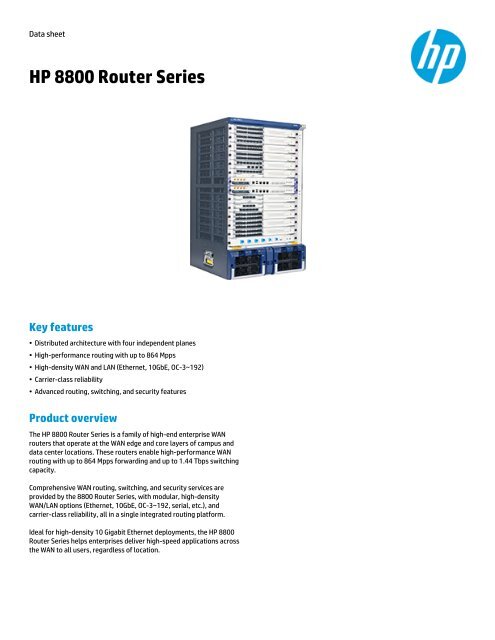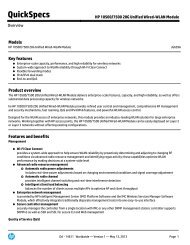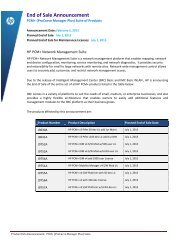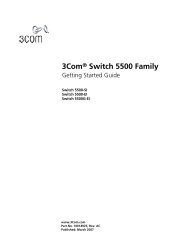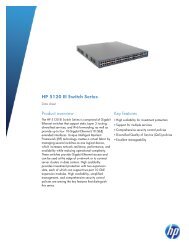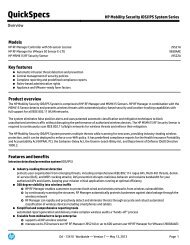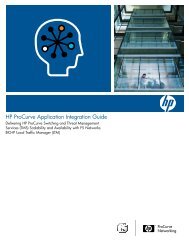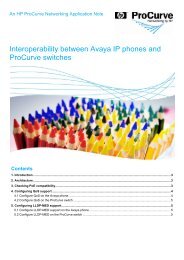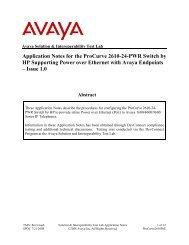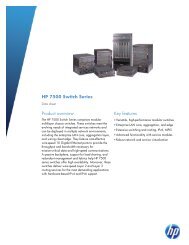Datasheet - HP Networking
Datasheet - HP Networking
Datasheet - HP Networking
Create successful ePaper yourself
Turn your PDF publications into a flip-book with our unique Google optimized e-Paper software.
Data sheet<br />
<strong>HP</strong> 8800 Router Series<br />
Key features<br />
• Distributed architecture with four independent planes<br />
• High-performance routing with up to 864 Mpps<br />
• High-density WAN and LAN (Ethernet, 10GbE, OC-3~192)<br />
• Carrier-class reliability<br />
• Advanced routing, switching, and security features<br />
Product overview<br />
The <strong>HP</strong> 8800 Router Series is a family of high-end enterprise WAN<br />
routers that operate at the WAN edge and core layers of campus and<br />
data center locations. These routers enable high-performance WAN<br />
routing with up to 864 Mpps forwarding and up to 1.44 Tbps switching<br />
capacity.<br />
Comprehensive WAN routing, switching, and security services are<br />
provided by the 8800 Router Series, with modular, high-density<br />
WAN/LAN options (Ethernet, 10GbE, OC-3~192, serial, etc.), and<br />
carrier-class reliability, all in a single integrated routing platform.<br />
Ideal for high-density 10 Gigabit Ethernet deployments, the <strong>HP</strong> 8800<br />
Router Series helps enterprises deliver high-speed applications across<br />
the WAN to all users, regardless of location.
Features and benefits<br />
Quality of Service (QoS)<br />
• Hierarchical QoS (HQoS)<br />
provides a built-in QoS engine that supports hierarchical QoS (HQoS)<br />
and can implement a hierarchical scheduling mechanism based on<br />
ports, user groups, users, and user services; also cooperates with<br />
MPLS traffic engineering (TE) to implement bandwidth reservation<br />
and scheduling based on tunnels and services<br />
• Schedule algorithm<br />
supports strict priority (SP) queuing, weighted round robin (WRR)<br />
queuing, weighted fair queuing (WFQ), class-based queuing (CBQ),<br />
and low latency queuing (LLQ)<br />
• Congestion avoidance mechanism<br />
supports tail drop and weighted random early detection (WRED)<br />
Management<br />
• Management interface control<br />
provides management access through modem port and terminal<br />
interface, as well as in-band and out-of-band Ethernet ports;<br />
provides access through terminal interface, telnet, or SSH<br />
• Industry-standard CLI with a hierarchical structure<br />
reduces training time and expenses, and increases productivity in<br />
multivendor installations<br />
• Management security<br />
includes multiple administration levels, with password protection<br />
and restricted access to critical configuration commands; access<br />
control lists (ACLs) provide telnet and SNMP access; local and<br />
remote syslog capability allows logging of all access<br />
• SNMP v1, v2, and v3<br />
provides complete support of SNMP as well as full support of<br />
industry-standard MIBs and private MIB extensions<br />
• Remote monitoring (RMON)<br />
uses standard SNMP to monitor essential network functions;<br />
supports events, alarm, history, and statistics group plus a private<br />
alarm extension group<br />
• Debug and sampler utility<br />
supports ping and traceroute for both IPv4 and IPv6<br />
• Network Quality Analyzer (NQA)<br />
analyzes network performance and service quality by sending test<br />
packets, and provides network performance and service quality<br />
parameters such as jitter, TCP, or FTP connection delays and file<br />
transfer rates; allows a network manager to determine overall<br />
network performance and to diagnose and locate network<br />
congestion points or failures<br />
• Network Time Protocol (NTP)<br />
synchronizes timekeeping among distributed time servers and<br />
clients; keeps timekeeping consistent among all clock-dependent<br />
devices within the network so that the devices can provide diverse<br />
applications based on the consistent time<br />
• Info center<br />
provides a central information center for system and network<br />
information; aggregates all logs, traps, and debugging information<br />
generated by the system and maintains them in order of severity;<br />
outputs the network information to multiple channels based on<br />
user-defined rules<br />
• FTP and TFTP support<br />
FTP allows bidirectional transfers over a TCP/IP network and is used<br />
for configuration updates; Trivial FTP is a simpler method using<br />
User Datagram Protocol (UDP)<br />
• Loopback<br />
supports internal loopback testing for maintenance purposes and<br />
high availability; loopback detection protects system from incorrect<br />
cabling or network configurations, and can be enabled on a port or<br />
VLAN<br />
• Ethernet OAM<br />
provides a monitoring tool for Layer 2 performance and fault<br />
detection, which reduces failover and network convergence times<br />
Connectivity<br />
• High port density<br />
provides up to 12 interface module slots, up to 192 OC3/OC12 POS<br />
ports, or 576 Gigabit Ethernet ports per 8812 system<br />
• Flexible port selection<br />
provides a combination of fiber and copper interface modules,<br />
100/1000BASE-X auto-speed selection, and 10/100/1000BASE-T<br />
auto-speed detection plus auto duplex and MDI/MDI-X; speed<br />
adaptable between 155 M POS and 622 M POS/Gigabit Ethernet<br />
• Packet storm protection<br />
protects against broadcast, multicast, or unicast storms with<br />
user-defined thresholds<br />
• Multiple WAN interfaces<br />
support Fast Ethernet/Gigabit Ethernet/10GbE ports, OC3~OC192<br />
POS, ATM ports, and 10GbE RPR<br />
Performance<br />
• Industry-leading performance<br />
provides switching capacity up to 1440 Gbps and forwarding<br />
performance up to 864 Mpps<br />
• Flexible chassis selection<br />
offers three models: 12 I/O-slot chassis, 8 I/O-slot chassis, 5<br />
I/O-slot chassis<br />
• Scalable system design<br />
enables smooth bandwidth upgrade<br />
Resiliency and high availability<br />
• Separate data and control plane<br />
provides continual services<br />
• Passive backplane design<br />
increases system reliability as backplane has no active components<br />
2
• Redundant design of main processing unit and power supply<br />
increases the overall system availability<br />
• IP Fast Reroute (FRR) framework<br />
provides nodes that are configured with backup ports and routes;<br />
local implementation requires no cooperation of adjacent devices,<br />
simplifying deployment; solves the traditional convergence faults in<br />
IP forwarding; realizes restoration within 50 ms, with the<br />
restoration time independent of the number of routes and fast link<br />
switchovers without route convergence<br />
• Hitless patch upgrades<br />
allow patches to be installed without restarting the equipment,<br />
increasing network uptime and facilitating maintenance<br />
• Virtual Router Redundancy Protocol<br />
helps facilitate the system's high availability without changing<br />
configurations when a device fails; prevents network interruptions<br />
caused by a single link failure<br />
• Graceful restart<br />
provides full support of graceful restart for OSPF, IS-IS, BGP, LDP,<br />
and RSVP; network remains stable during the active-standby<br />
switchover; after the switchover, the device quickly learns the<br />
network routes by communicating with adjacent routers; forwarding<br />
remains uninterrupted during the switchover to realize NSF<br />
• Hot-swappable modules<br />
facilitates the replacement of hardware interface modules without<br />
impacting the traffic flow through the system<br />
• Bidirectional forwarding detection (BFD)<br />
Enables static routing, RIP, OSPF, OSPFv3, IS-IS, IPv6 IS-IS, BGP,<br />
BGP4+, PIM, IPv6 PIM, LDP, RSVP, VPLS PW, LSP, VRRP, VRRP3,<br />
VRRPE, policy route, TE FRR, and IP FRR<br />
Layer 2 switching<br />
• VLANs<br />
support up to 4,096 port or IEEE 802.1Q-based VLANs<br />
• Spanning Tree Protocol<br />
fully supports standard IEEE 802.1D Spanning Tree Protocol, IEEE<br />
802.1w Rapid Spanning Tree Protocol for faster convergence, and<br />
IEEE 802.1s Multiple Spanning Tree Protocol<br />
• Bridge Protocol Data Unit (BPDU) tunneling<br />
transmits Spanning Tree Protocol BPDUs transparently, allowing<br />
correct tree calculations across service providers, WANs, or MANs<br />
• Internet Group Management Protocol (IGMP) and Multicast<br />
Listener Discovery (MLD) protocol snooping<br />
effectively control and manage the flooding of multicast packets in<br />
a Layer 2 network<br />
• Port mirroring<br />
duplicates port traffic (ingress and egress) to a local or remote<br />
monitoring port; supports 64 mirroring groups, with an unlimited<br />
number of ports per group<br />
• Port isolation<br />
increases security by isolating ports within a VLAN while still<br />
allowing them to communicate with other VLANs<br />
Layer 3 services<br />
• Address Resolution Protocol (ARP)<br />
determines the MAC address of another IP host in the same subnet;<br />
supports static ARPs; gratuitous ARP allows detection of duplicate<br />
IP addresses; proxy ARP allows normal ARP operation between<br />
subnets or when subnets are separated by a Layer 2 network<br />
• User Datagram Protocol (UDP) helper<br />
redirects UDP broadcasts to specific IP subnets to prevent server<br />
spoofing<br />
• Dynamic Host Configuration Protocol (DHCP)<br />
simplifies the management of large IP networks and supports client<br />
and server; DHCP Relay enables DHCP operation across subnets<br />
• Domain Name System (DNS)<br />
provides a distributed database that translates domain names and<br />
IP addresses, which simplifies network design; supports client and<br />
server<br />
Layer 3 routing<br />
• Static IPv4 routing<br />
provides simple, manually configured IPv4 routing<br />
• Routing Information Protocol (RIP)<br />
uses a distance vector algorithm with UDP packets for route<br />
determination; supports RIPv1 and RIPv2 routing; includes loop<br />
protection<br />
• OSPF<br />
Interior Gateway Protocol (IGP) uses link-state protocol for faster<br />
convergence; supports ECMP, NSSA, and MD5 authentication for<br />
increased security and graceful restart for faster failure recovery<br />
• Intermediate system to intermediate system (IS-IS)<br />
Interior Gateway Protocol (IGP) uses path vector protocol, which is<br />
defined by the ISO organization for IS-IS routing and extended by<br />
IETF RFC 1195 to operate in both TCP/IP and the OSI reference<br />
model (Integrated IS-IS)<br />
• Static IPv6 routing<br />
provides simple, manually configured IPv6 routing<br />
• Dual IP stack<br />
maintains separate stacks for IPv4 and IPv6 to ease the transition<br />
from an IPv4-only network to an IPv6-only network design<br />
• Routing Information Protocol next generation (RIPng)<br />
extends RIPv2 to support IPv6 addressing<br />
• OSPFv3<br />
provides OSPF support for IPv6<br />
• BGP+<br />
extends BGP-4 to support Multiprotocol BGP (MBGP), including<br />
support for IPv6 addressing<br />
• IS-IS for IPv6<br />
extends IS-IS to support IPv6 addressing<br />
3
• Multiprotocol Label Switching Traffic Engineering (MPLS TE)<br />
Traffic Engineering (TE) is used to enhance traffic over large MPLS<br />
networks based on type of traffic and available resources; TE<br />
dynamically tunes traffic management attributes and enables true<br />
load balancing; MPLS TE supports route backup using Fast Reroute<br />
(FRR)<br />
• Multiprotocol Label Switching (MPLS) Layer 3 VPN<br />
allows Layer 3 VPNs across a provider network; uses MP-BGP to<br />
establish private routes for increased security; supports RFC<br />
2547bis multiple autonomous system VPNs for added flexibility<br />
• Multiprotocol Label Switching (MPLS) Layer 2 VPN<br />
establishes simple Layer 2 point-to-point VPNs across a provider<br />
network using only MPLS Label Distribution Protocol (LDP); requires<br />
no routing and therefore decreases complexity, increases<br />
performance, and allows VPNs of non-routable protocols; uses no<br />
routing information for increased security; supports Circuit Cross<br />
Connect (CCC), Static Virtual Circuits (SVCs), Martini draft, and<br />
Kompella-draft technologies<br />
• Virtual Private LAN Service (VPLS)<br />
establishes point-to-multipoint Layer 2 VPNs across a provider<br />
network<br />
• Policy routing<br />
allows custom filters for increased performance and security;<br />
supports ACLs, IP prefix, AS paths, community lists, and aggregate<br />
policies<br />
• Bidirectional Forwarding Detection (BFD)<br />
enables link connectivity monitoring and reduces network<br />
convergence time for RIP, OSPF, BGP, IS-IS, VRRP, MPLS, and IRF<br />
• Multicast VPN<br />
supports Multicast Domain (MD) multicast VPN, which can be<br />
distributed on separate service cards, providing high performance<br />
and flexible configuration<br />
• IPv6 tunneling<br />
is important for the transition from IPv4 to IPv6 as it allows IPv6<br />
packets to traverse IPv4-only networks by encapsulating the IPv6<br />
packet into a standard IPv4 packet; supports manually configured<br />
6to4 and Intra-Site Automatic Tunnel Addressing Protocol (ISATAP)<br />
tunnels<br />
• Border Gateway Protocol 4<br />
Exterior Gateway Protocol (EGP) with path vector protocol uses TCP<br />
to enhance reliability for the route discovery process, reduce<br />
bandwidth consumption by advertising only incremental updates,<br />
and support extensive policies to increase flexibility and scale to<br />
large networks<br />
Security<br />
• Access control list (ACL)<br />
supports powerful ACLs for both IPv4 and IPv6; ACLs are used for<br />
filtering traffic to prevent unauthorized users from accessing the<br />
network, or for controlling network traffic to save resources; rules<br />
can either deny or permit traffic to be forwarded; rules can be based<br />
on a Layer 2 header or a Layer 3 protocol header; rules can be set to<br />
operate on specific dates or times<br />
• Network login<br />
standard IEEE 802.1X allows authentication of multiple users per<br />
port, or when a port is shared with an IP phone<br />
• RADIUS<br />
eases switch security access administration by using a password<br />
authentication server<br />
• TACACS+<br />
is an authentication tool using TCP with encryption of the full<br />
authentication request that provides additional security<br />
• Media access control (MAC) authentication<br />
provides simple authentication based on a user's MAC address;<br />
supports local or RADIUS-based authentication<br />
• Attack protection<br />
protects network from attacks that use a large number of ARP<br />
requests by using a host-specific, user-selectable threshold;<br />
provides Address Scanning Attack Prevention, MAC Address<br />
Flooding Attack Prevention, and STP Attack Prevention<br />
• Network address translation (NAT)<br />
supports repeated multiplexing of a port and automatic 5-tuple<br />
collision detection, enabling NAPT to support unlimited connections;<br />
supports blacklist in NAT/NAPT/internal server, a limit on the<br />
number of connections, session log, and multi-instance<br />
• Secure shell (SSHv2)<br />
uses external servers to securely log in to a remote device; with<br />
authentication and encryption, it protects against IP spoofing and<br />
plain-text password interception; increases the security of Secure<br />
FTP (SFTP) transfers<br />
• Unicast Reverse Path Forwarding (URPF)<br />
allows normal packets to be forwarded correctly, but discards the<br />
attaching packet due to lack of reverse path route or incorrect<br />
inbound interface; prevents source spoofing and distributed<br />
attacks; supports distributed URPF<br />
Multicast support<br />
• Internet Group Management Protocol (IGMP)<br />
Establishes and maintains multicast groups; supports v1, v2, and<br />
v3; utilizes any-source multicast (ASM) or source-specific multicast<br />
(SSM) to manage IPv4 multicast networks<br />
• Protocol Independent Multicast (PIM)<br />
is used for IPv4 and IPv6 multicast applications; supports PIM dense<br />
mode (PIM-DM), sparse mode (PIM-SM), and source-specific mode<br />
(PIM-SSM)<br />
• Multicast Source Discovery Protocol (MSDP)<br />
is used for inter-domain multicast applications, allowing multiple<br />
PIM-SM domains to interoperate<br />
• Multicast Border Gateway Protocol (MBGP)<br />
allows multicast traffic to be forwarded across BGP networks,<br />
separate from unicast traffic<br />
4
• Multicast Listener Discovery Protocol<br />
is used by IP hosts to establish and maintain multicast groups;<br />
supports v1 and v2 and utilizes any-source multicast (ASM) or<br />
source-specific multicast (SSM) to manage IPv6 multicast networks<br />
• Multicast VLAN<br />
allows multiple VLANs to receive the same IPv4 or IPv6 multicast<br />
traffic, reducing network bandwidth demand by decreasing multiple<br />
streams to each VLAN<br />
Integration<br />
• Open application architecture<br />
provides both software and hardware platform based on open<br />
standards, so third-party applications can be integrated seamlessly<br />
into <strong>HP</strong> 8800 routers<br />
• Electronic and telephone support<br />
limited electronic and telephone support is available from <strong>HP</strong>; to<br />
reach our support centers, refer to<br />
www.hp.com/networking/contact-support; for details on the<br />
duration of support provided with your product purchase, refer to<br />
www.hp.com/networking/warrantysummary<br />
• Software releases<br />
to find software for your product, refer to<br />
www.hp.com/networking/support; for details on the software<br />
releases available with your product purchase, refer to<br />
www.hp.com/networking/warrantysummary<br />
Additional information<br />
• Green initiative support<br />
provides support for RoHS and WEEE regulations<br />
Product architecture<br />
• 10 Gbps network processor platform<br />
supports wire-speed 10GbE POS and precise QoS/H-QoS and<br />
multicast VPN, making it perfect for new service expansion<br />
• Crossbar nonblocking switching<br />
includes two crossbars on MCU to provide performance and<br />
reliability; service processing engine and crossbar work together to<br />
complete VoQ and E2E flow control and implement granular<br />
switch-fabric-level QoS, offering genuine SLA services<br />
• 10 GbE Resilient Packet Ring (RPR)<br />
provides advanced technology on MAC layer with high usage of ring<br />
bandwidth, self-healing, automatic topology discovery, and node<br />
plug and play; provides protection switching using steering or<br />
wrapping, with fast recovery time of 50 ms, satisfying the<br />
carrier-class requirement; provides weighted fair algorithm for<br />
bandwidth allocation<br />
• High-capacity buffer<br />
provides time-delay-sensitive services, as each network processor<br />
of the 8800 router offers a 200 ms ingress buffer and a 200 ms<br />
egress buffer<br />
• Separate service processing engine (SPE) and interface cards<br />
support flexible service configurations, as the SPE and interface<br />
cards can be upgraded separately<br />
• Dedicated OAM engine<br />
reduces CPU loads and improves link fault detection performance;<br />
realizes 30 ms fault detection and 20 ms service switchover<br />
Warranty and support<br />
• 1-year warranty<br />
with advance replacement and 10-calendar-day delivery (available<br />
in most countries)<br />
5
<strong>HP</strong> 8800 Router Series<br />
Specifications<br />
<strong>HP</strong> 8812 Router Chassis (JC150B) <strong>HP</strong> 8808-V Router Chassis (JC149B) <strong>HP</strong> 8805 Router Chassis (JC148B)<br />
Ports<br />
12 I/O module slots<br />
8 I/O module slots<br />
5 I/O module slots<br />
2 MPU (for management modules) slots<br />
2 MPU (for management modules) slots<br />
2 MPU (for management modules) slots<br />
Physical characteristics<br />
17.4(w) x 17.72(d) x 29.65(h) in (44.2 x 45.01 x 75.31<br />
cm) (17U height)<br />
17.4(w) x 17.72(d) x 34.88(h) in (44.2 x 45.01 x 88.6 cm)<br />
(21U height)<br />
Full configuration weight 264.55 lb (120 kg) 242.5 lb (110 kg) 187.39 lb (85 kg)<br />
Mounting EIA standard 19 in. rack EIA standard 19 in. rack EIA standard 19 in. rack<br />
Performance<br />
Throughput up to 864 million pps up to 576 million pps up to 360 million pps<br />
Routing/Switching capacity 1.4 Tbps 960 Gbps 600 Gbps<br />
Routing table size 3000000 entries 3000000 entries 3000000 entries<br />
Environment<br />
17.4(w) x 17.72(d) x 19.13(h) in (44.2 x 45.01 x 48.59<br />
cm) (11U height)<br />
Operating temperature 32°F to 113°F (0°C to 45°C) 32°F to 113°F (0°C to 45°C) 32°F to 113°F (0°C to 45°C)<br />
Operating relative humidity 10% to 90%, noncondensing 10% to 90%, noncondensing 10% to 90%, noncondensing<br />
Nonoperating/Storage temperature -40°F to 158°F (-40°C to 70°C) -40°F to 158°F (-40°C to 70°C) -40°F to 158°F (-40°C to 70°C)<br />
Nonoperating/Storage relative humidity 5% to 95%, noncondensing 5% to 95%, noncondensing 5% to 95%, noncondensing<br />
Electrical characteristics<br />
Maximum heat dissipation 11935 BTU/hr (12591.43 kJ/hr) 11935 BTU/hr (12591.43 kJ/hr) 6820 BTU/hr (7195.1 kJ/hr)<br />
Voltage 100-120/200-240 VAC 100-120/200-240 VAC 100-120/200-240 VAC<br />
DC voltage -48 VDC -48 VDC -48 VDC<br />
Maximum power rating 3500 W 3500 W 2000 W<br />
Frequency 50/60 Hz 50/60 Hz 50/60 Hz<br />
Notes<br />
Maximum power rating and maximum heat dissipation<br />
are the worst-case theoretical maximum numbers<br />
provided for planning the infrastructure with fully<br />
loaded PoE (if equipped), 100% traffic, all ports plugged<br />
in, and all modules populated.<br />
Maximum power rating and maximum heat dissipation<br />
are the worst-case theoretical maximum numbers<br />
provided for planning the infrastructure with fully<br />
loaded PoE (if equipped), 100% traffic, all ports plugged<br />
in, and all modules populated.<br />
Maximum power rating and maximum heat dissipation<br />
are the worst-case theoretical maximum numbers<br />
provided for planning the infrastructure with fully<br />
loaded PoE (if equipped), 100% traffic, all ports plugged<br />
in, and all modules populated.<br />
Safety CSA 22.2 No. 60950; cUL (CSA 22.2 No. 60950); CSA 22.2<br />
No. 60950 3rd edition; CSA 22.2 No. 950; CSA 950; cUL<br />
(CSA 950); EN 60950/IEC 60950; UL 1950 3rd edition; UL<br />
1950; UL 60950; UL 60950-1; CAN/CSA 22.2 No. 60950;<br />
CAN/CSA 22.2 No. 60950-1; AS/NZS 60950; EN 609500<br />
Safety Information Technology Equipment; UL 60950;<br />
CSA 22.2 No. 60950/cUL; IEC 60950; IEC 60950-1; EN<br />
60950; EN 60950-1; CSA 22.2 No. 950-95; IEC<br />
60950-1:2001 (with CB Report); CAN/CSA-C22.2 No.<br />
60950-1; CSA 60950-1; CSA C22.2 60950-1; EN<br />
60950-1/A11; CSA 22.2 60950-1; EN 60950: 2000, ZB<br />
and ZC Deviations; IEC 60950: 1999, Corr Feb 2000, all<br />
national deviations; As/NZS 60950:2000, Australia; UL<br />
60950-1:2003; UL 60950-1:2001; CSA 22.2<br />
60950-1:2003; IEC 60950-1:2001; EN 60950-1:2001;<br />
CSA 22.2-60950; AS/NZS 60950: 2000 Australia, Russian<br />
GOST Safety Approval; CSA 22.2 No. 950 3rd Edition<br />
1995; UL 60950 3rd Edition; CAN/CSA 22.2 No.<br />
60950-00/UL 60950 3rd Edition, Safety Information for<br />
Technology Equipment; EN 60950/IEC 60950 3rd<br />
Edition; UL 60950 Standard for the Safety of Information<br />
Technology Equipment<br />
CSA 22.2 No. 60950; cUL (CSA 22.2 No. 60950); CSA 22.2<br />
No. 60950 3rd edition; CSA 22.2 No. 950; CSA 950; cUL<br />
(CSA 950); EN 60950/IEC 60950; UL 1950 3rd edition; UL<br />
1950; UL 60950; UL 60950-1; CAN/CSA 22.2 No. 60950;<br />
CAN/CSA 22.2 No. 60950-1; AS/NZS 60950; EN 609500<br />
Safety Information Technology Equipment; UL 60950;<br />
CSA 22.2 No. 60950/cUL; IEC 60950; IEC 60950-1; EN<br />
60950; EN 60950-1; CSA 22.2 No. 950-95; IEC<br />
60950-1:2001 (with CB Report); CAN/CSA-C22.2 No.<br />
60950-1; CSA 60950-1; CSA C22.2 60950-1; EN<br />
60950-1/A11; CSA 22.2 60950-1; EN 60950: 2000, ZB<br />
and ZC Deviations; IEC 60950: 1999, Corr Feb 2000, all<br />
national deviations; As/NZS 60950:2000, Australia; UL<br />
60950-1:2003; UL 60950-1:2001; CSA 22.2<br />
60950-1:2003; IEC 60950-1:2001; EN 60950-1:2001;<br />
CSA 22.2-60950; AS/NZS 60950: 2000 Australia, Russian<br />
GOST Safety Approval; CSA 22.2 No. 950 3rd Edition<br />
1995; UL 60950 3rd Edition; CAN/CSA 22.2 No.<br />
60950-00/UL 60950 3rd Edition, Safety Information for<br />
Technology Equipment; EN 60950/IEC 60950 3rd<br />
Edition; UL 60950 Standard for the Safety of Information<br />
Technology Equipment<br />
CSA 22.2 No. 60950; cUL (CSA 22.2 No. 60950); CSA 22.2<br />
No. 60950 3rd edition; CSA 22.2 No. 950; CSA 950; cUL<br />
(CSA 950); EN 60950/IEC 60950; UL 1950 3rd edition; UL<br />
1950; UL 60950; UL 60950-1; CAN/CSA 22.2 No. 60950;<br />
CAN/CSA 22.2 No. 60950-1; AS/NZS 60950; EN 609500<br />
Safety Information Technology Equipment; UL 60950;<br />
CSA 22.2 No. 60950/cUL; IEC 60950; IEC 60950-1; EN<br />
60950; EN 60950-1; CSA 22.2 No. 950-95; IEC<br />
60950-1:2001 (with CB Report); CAN/CSA-C22.2 No.<br />
60950-1; CSA 60950-1; CSA C22.2 60950-1; EN<br />
60950-1/A11; CSA 22.2 60950-1; EN 60950: 2000, ZB<br />
and ZC Deviations; IEC 60950: 1999, Corr Feb 2000, all<br />
national deviations; As/NZS 60950:2000, Australia; UL<br />
60950-1:2003; UL 60950-1:2001; CSA 22.2<br />
60950-1:2003; IEC 60950-1:2001; EN 60950-1:2001;<br />
CSA 22.2-60950; AS/NZS 60950: 2000 Australia, Russian<br />
GOST Safety Approval; CSA 22.2 No. 950 3rd Edition<br />
1995; UL 60950 3rd Edition; CAN/CSA 22.2 No.<br />
60950-00/UL 60950 3rd Edition, Safety Information for<br />
Technology Equipment; EN 60950/IEC 60950 3rd<br />
Edition; UL 60950 Standard for the Safety of Information<br />
Technology Equipment<br />
6
<strong>HP</strong> 8800 Router Series<br />
Specifications (continued)<br />
<strong>HP</strong> 8812 Router Chassis (JC150B) <strong>HP</strong> 8808-V Router Chassis (JC149B) <strong>HP</strong> 8805 Router Chassis (JC148B)<br />
Emissions<br />
FCC Class A; FCC part 15 Class A; ICE-003, Canadian Radio<br />
Interface Regulation; EN 55022/CISPR-22 Class A; VCCI<br />
Class A; EN 55022/CISPR 22 Class A; EN 55022 Class A;<br />
CISPR 22; CISPR 22 Class A; EN 55022; EN 55024; CNS<br />
13438 Class B; FCC CFR 47 Part 15; VCCI; ICES-003<br />
(Canada); CISPR 22/A2; EN 55022/A2; ICES-003; AS/NZS<br />
CISPR 22; VCCI V-3/2000.04; IEC/EN 61000-3-2; IEC/EN<br />
61000-3-3; EN 55024/A1; IEC 61000:4-2, 4-3, 4-4, 4-5,<br />
4-6, 4-8, 4-11; EMC Directive 89/336/EEC; VCCI (Japan);<br />
EN 55022 1998 Class A; EN 61000-3-2 2000, 61000-3-3;<br />
ICES-003 Class A; EN 300 386; FCC Part 15; CISPR 24;<br />
ETSI EN 300 386 V1.3.3; AS/NZS CISPR22 Class A; EN<br />
61000-3-2; EN 61000-3-3; CNS 13438 Class A; EN<br />
55024:1998; EN 61000-4-2; EN 61000-4-3; EN<br />
61000-4-4; EN 61000-4-5; EN 61000-4-6; EN<br />
61000-4-11; Anatel; ICES-003 Issue 4 Class A; CS-03;<br />
FCC Part 68<br />
FCC Class A; FCC part 15 Class A; ICE-003, Canadian Radio<br />
Interface Regulation; EN 55022/CISPR-22 Class A; VCCI<br />
Class A; EN 55022/CISPR 22 Class A; EN 55022 Class A;<br />
CISPR 22; CISPR 22 Class A; EN 55022; EN 55024; CNS<br />
13438 Class B; FCC CFR 47 Part 15; VCCI; ICES-003<br />
(Canada); CISPR 22/A2; EN 55022/A2; ICES-003; AS/NZS<br />
CISPR 22; VCCI V-3/2000.04; IEC/EN 61000-3-2; IEC/EN<br />
61000-3-3; EN 55024/A1; IEC 61000:4-2, 4-3, 4-4, 4-5,<br />
4-6, 4-8, 4-11; EMC Directive 89/336/EEC; VCCI (Japan);<br />
EN 55022 1998 Class A; EN 61000-3-2 2000, 61000-3-3;<br />
ICES-003 Class A; EN 300 386; FCC Part 15; CISPR 24;<br />
ETSI EN 300 386 V1.3.3; AS/NZS CISPR22 Class A; EN<br />
61000-3-2; EN 61000-3-3; CNS 13438 Class A; EN<br />
55024:1998; EN 61000-4-2; EN 61000-4-3; EN<br />
61000-4-4; EN 61000-4-5; EN 61000-4-6; EN<br />
61000-4-11; Anatel; ICES-003 Issue 4 Class A; CS-03;<br />
FCC Part 68<br />
FCC Class A; FCC part 15 Class A; ICE-003, Canadian Radio<br />
Interface Regulation; EN 55022/CISPR-22 Class A; VCCI<br />
Class A; EN 55022/CISPR 22 Class A; EN 55022 Class A;<br />
CISPR 22; CISPR 22 Class A; EN 55022; EN 55024; CNS<br />
13438 Class B; FCC CFR 47 Part 15; VCCI; ICES-003<br />
(Canada); CISPR 22/A2; EN 55022/A2; ICES-003; AS/NZS<br />
CISPR 22; VCCI V-3/2000.04; IEC/EN 61000-3-2; IEC/EN<br />
61000-3-3; EN 55024/A1; IEC 61000:4-2, 4-3, 4-4, 4-5,<br />
4-6, 4-8, 4-11; EMC Directive 89/336/EEC; VCCI (Japan);<br />
EN 55022 1998 Class A; EN 61000-3-2 2000, 61000-3-3;<br />
ICES-003 Class A; EN 300 386; FCC Part 15; CISPR 24;<br />
ETSI EN 300 386 V1.3.3; AS/NZS CISPR22 Class A; EN<br />
61000-3-2; EN 61000-3-3; CNS 13438 Class A; EN<br />
55024:1998; EN 61000-4-2; EN 61000-4-3; EN<br />
61000-4-4; EN 61000-4-5; EN 61000-4-6; EN<br />
61000-4-11; Anatel; ICES-003 Issue 4 Class A; CS-03;<br />
FCC Part 68<br />
Management<br />
IMC - Intelligent Management Center; command-line<br />
interface; limited command-line interface; configuration<br />
menu; out-of-band management (serial RS-232C);<br />
out-of-band management; SNMP Manager; Telnet;<br />
RMON1; FTP; in-line and out-of-band; terminal interface<br />
(serial RS-232C); modem interface; IEEE 802.3 Ethernet<br />
MIB; Ethernet Interface MIB<br />
IMC - Intelligent Management Center; command-line<br />
interface; limited command-line interface; configuration<br />
menu; out-of-band management (serial RS-232C);<br />
out-of-band management; SNMP Manager; Telnet;<br />
RMON1; FTP; in-line and out-of-band; terminal interface<br />
(serial RS-232C); modem interface; IEEE 802.3 Ethernet<br />
MIB; Ethernet Interface MIB<br />
IMC - Intelligent Management Center; command-line<br />
interface; limited command-line interface; configuration<br />
menu; out-of-band management (serial RS-232C);<br />
out-of-band management; SNMP Manager; Telnet;<br />
RMON1; FTP; in-line and out-of-band; terminal interface<br />
(serial RS-232C); modem interface; IEEE 802.3 Ethernet<br />
MIB; Ethernet Interface MIB<br />
Notes<br />
Throughput forwarding performance depends on<br />
features enabled<br />
Throughput forwarding performance depends on<br />
features enabled<br />
Throughput forwarding performance depends on<br />
features enabled<br />
Services<br />
Refer to the <strong>HP</strong> website at<br />
www.hp.com/networking/services for details on the<br />
service-level descriptions and product numbers. For<br />
details about services and response times in your area,<br />
please contact your local <strong>HP</strong> sales office.<br />
Refer to the <strong>HP</strong> website at<br />
www.hp.com/networking/services for details on the<br />
service-level descriptions and product numbers. For<br />
details about services and response times in your area,<br />
please contact your local <strong>HP</strong> sales office.<br />
Refer to the <strong>HP</strong> website at<br />
www.hp.com/networking/services for details on the<br />
service-level descriptions and product numbers. For<br />
details about services and response times in your area,<br />
please contact your local <strong>HP</strong> sales office.<br />
7
<strong>HP</strong> 8800 Router Series<br />
Specifications (continued)<br />
<strong>HP</strong> 8812 Router Chassis (JC150B) <strong>HP</strong> 8808-V Router Chassis (JC149B) <strong>HP</strong> 8805 Router Chassis (JC148B)<br />
Standards and protocols<br />
(applies to all products in series)<br />
BGP<br />
RFC 1267 Border Gateway Protocol 3 (BGP-3)<br />
RFC 1657 Definitions of Managed Objects for BGPv4<br />
RFC 1771 BGPv4<br />
RFC 1772 Application of the BGP<br />
RFC 1773 Experience with the BGP-4 Protocol<br />
RFC 1774 BGP-4 Protocol Analysis<br />
RFC 1965 BGP4 confederations<br />
RFC 1997 BGP Communities Attribute<br />
RFC 1998 PPP Gandalf FZA Compression Protocol<br />
RFC 2385 BGP Session Protection via TCP MD5<br />
RFC 2439 BGP Route Flap Damping<br />
RFC 2796 BGP Route Reflection<br />
RFC 2842 Capability Advertisement with BGP-4<br />
RFC 2858 BGP-4 Multi-Protocol Extensions<br />
RFC 2918 Route Refresh Capability<br />
Denial of service protection<br />
CPU DoS Protection<br />
Rate Limiting by ACLs<br />
Device management<br />
RFC 1155 Structure and Mgmt Information (SMIv1)<br />
RFC 1157 SNMPv1/v2c<br />
RFC 1305 NTPv3<br />
RFC 1901 (Community based SNMPv2)<br />
RFC 1901-1907 SNMPv2c, SMIv2 and Revised MIB-II<br />
RFC 1902 (SNMPv2)<br />
RFC 1908 (SNMP v1/2 Coexistence)<br />
RFC 1945 Hypertext Transfer Protocol -- HTTP/1.0<br />
RFC 2068 Hypertext Transfer Protocol -- HTTP/1.1<br />
RFC 2271 FrameWork<br />
RFC 2452 MIB for TCP6<br />
RFC 2454 MIB for UDP6<br />
RFC 2573 (SNMPv3 Applications)<br />
RFC 2576 (Coexistence between SNMP V1, V2, V3)<br />
RFC 2578-2580 SMIv2<br />
RFC 2579 (SMIv2 Text Conventions)<br />
RFC 2580 (SMIv2 Conformance)<br />
RFC 2819 (RMON groups Alarm, Event, History and<br />
Statistics only)<br />
RFC 2819 RMON<br />
RFC 3410 (Management Framework)<br />
RFC 3416 (SNMP Protocol Operations v2)<br />
RFC 3417 (SNMP Transport Mappings)<br />
Multiple Configuration Files<br />
Multiple Software Images<br />
SNMP v3 and RMON RFC support<br />
SSHv1/SSHv2 Secure Shell<br />
TACACS/TACACS+<br />
General protocols<br />
IEEE 802.1ad Q-in-Q<br />
IEEE 802.1ad Q-in-Q<br />
IEEE 802.1ag Service Layer OAM<br />
IEEE 802.1ah Provider Backbone Bridges<br />
IEEE 802.1AX-2008 Link Aggregation<br />
IEEE 802.1D MAC Bridges<br />
IEEE 802.1p Priority<br />
IEEE 802.1Q (GVRP)<br />
IEEE 802.1Q VLANs<br />
IEEE 802.1s (MSTP)<br />
IEEE 802.1s Multiple Spanning Trees<br />
IEEE 802.1v VLAN classification by Protocol and Port<br />
IEEE 802.1w Rapid Reconfiguration of Spanning Tree<br />
IEEE 802.1X PAE<br />
IEEE 802.3 Type 10BASE-T<br />
IEEE 802.3ab 1000BASE-T<br />
IEEE 802.3ac (VLAN Tagging Extension)<br />
IEEE 802.3ad Link Aggregation (LAG)<br />
IEEE 802.3ad Link Aggregation Control Protocol (LACP)<br />
IEEE 802.3ae 10-Gigabit Ethernet<br />
IEEE 802.3ag Ethernet OAM<br />
IEEE 802.3ah Ethernet in First Mile over Point to Point<br />
Fiber - EFMF<br />
IEEE 802.3i 10BASE-T<br />
IEEE 802.3u 100BASE-X<br />
IEEE 802.3x Flow Control<br />
IEEE 802.3z 1000BASE-X<br />
RFC 768 UDP<br />
RFC 783 TFTP Protocol (revision 2)<br />
RFC 791 IP<br />
RFC 792 ICMP<br />
RFC 793 TCP<br />
RFC 826 ARP<br />
RFC 854 TELNET<br />
RFC 855 Telnet Option Specification<br />
RFC 856 TELNET<br />
RFC 857 Telnet Echo Option<br />
RFC 858 Telnet Suppress Go Ahead Option<br />
RFC 894 IP over Ethernet<br />
RFC 896 Congestion Control in IP/TCP Internetworks<br />
RFC 906 TFTP Bootstrap<br />
RFC 925 Multi-LAN Address Resolution<br />
RFC 950 Internet Standard Subnetting Procedure<br />
RFC 951 BOOTP<br />
RFC 959 File Transfer Protocol (FTP)<br />
RFC 1006 ISO transport services on top of the TCP:<br />
Version 3<br />
RFC 1027 Proxy ARP<br />
RFC 1034 Domain Concepts and Facilities<br />
RFC 1035 Domain Implementation and Specification<br />
RFC 1042 IP Datagrams<br />
RFC 1058 RIPv1<br />
RFC 1071 Computing the Internet Checksum<br />
RFC 1091 Telnet Terminal-Type Option<br />
RFC 1093 NSFNET routing architecture<br />
RFC 1122 Host Requirements<br />
RFC 1141 Incremental updating of the Internet<br />
checksum<br />
RFC 1142 OSI IS-IS Intra-domain Routing Protocol<br />
RFC 1144 Compressing TCP/IP headers for low-speed<br />
serial links<br />
RFC 1171 Point-to-Point Protocol for the transmission<br />
of multi-protocol datagrams over Point-to-Point links<br />
RFC 1195 OSI ISIS for IP and Dual Environments<br />
RFC 1213 Management Information Base for Network<br />
Management of TCP/IP-based internets<br />
RFC 1253 (OSPF v2)<br />
RFC 1256 ICMP Router Discovery Protocol (IRDP)<br />
RFC 1293 Inverse Address Resolution Protocol<br />
RFC 1305 NTPv3<br />
RFC 1315 Management Information Base for Frame<br />
Relay DTEs<br />
RFC 1321 The MD5 Message-Digest Algorithm<br />
RFC 1332 The PPP Internet Protocol Control Protocol<br />
(IPCP)<br />
RFC 1333 PPP Link Quality Monitoring<br />
RFC 1334 PPP Authentication Protocols (PAP)<br />
RFC 1349 Type of Service<br />
RFC 1350 TFTP Protocol (revision 2)<br />
RFC 1377 The PPP OSI Network Layer Control Protocol<br />
(OSINLCP)<br />
RFC 1381 SNMP MIB Extension for X.25 LAPB<br />
RFC 1389 RIPv2 MIB Extension<br />
RFC 1471 The Definitions of Managed Objects for the<br />
Link Control Protocol of the Point-to-Point Protocol<br />
RFC 1472 The Definitions of Managed Objects for the<br />
Security Protocols of the Point-to-Point Protocol<br />
RFC 1490 Multiprotocol Interconnect over Frame Relay<br />
RFC 1519 CIDR<br />
RFC 1531 Dynamic Host Configuration Protocol<br />
RFC 1533 DHCP Options and BOOTP Vendor Extensions<br />
RFC 1534 DHCP/BOOTP Interoperation<br />
RFC 1541 DHCP<br />
RFC 1542 BOOTP Extensions<br />
RFC 1542 Clarifications and Extensions for the Bootstrap<br />
Protocol<br />
RFC 1552 The PPP Internetworking Packet Exchange<br />
Control Protocol (IPXCP)<br />
RFC 1577 Classical IP and ARP over ATM<br />
RFC 1631 NAT<br />
RFC 1638 PPP Bridging Control Protocol (BCP)<br />
RFC 1661 The Point-to-Point Protocol (PPP)<br />
RFC 1662 PPP in HDLC-like Framing<br />
RFC 1695 Definitions of Managed Objects for ATM<br />
Management Version 8.0 using SMIv2<br />
RFC 1701 Generic Routing Encapsulation<br />
RFC 1702 Generic Routing Encapsulation over IPv4<br />
networks<br />
RFC 1721 RIP-2 Analysis<br />
RFC 1722 RIP-2 Applicability<br />
RFC 1723 RIP v2<br />
RFC 1812 IPv4 Routing<br />
RFC 1829 The ESP DES-CBC Transform<br />
RFC 1877 PPP Internet Protocol Control Protocol<br />
Extensions for Name Server Addresses<br />
RFC 1944 Benchmarking Methodology for Network<br />
Interconnect Devices<br />
RFC 1945 Hypertext Transfer Protocol -- HTTP/1.0<br />
RFC 1973 PPP in Frame Relay<br />
RFC 1974 PPP Stac LZS Compression Protocol<br />
RFC 1981 Path MTU Discovery for IP version 6<br />
RFC 1990 The PPP Multilink Protocol (MP)<br />
RFC 1994 PPP Challenge Handshake Authentication<br />
Protocol (CHAP)<br />
RFC 2082 RIP-2 MD5 Authentication<br />
RFC 2091 Trigger RIP<br />
RFC 2104 HMAC: Keyed-Hashing for Message<br />
Authentication<br />
RFC 2131 DHCP<br />
RFC 2132 DHCP Options and BOOTP Vendor Extensions<br />
RFC 2138 Remote Authentication Dial In User Service<br />
(RADIUS)<br />
RFC 2205 Resource ReSerVation Protocol (RSVP) -<br />
Version 1 Functional Specification<br />
RFC 2209 Resource ReSerVation Protocol (RSVP) --<br />
Version 1 Message Processing Rules<br />
RFC 2236 IGMP Snooping<br />
RFC 2246 The TLS Protocol Version 1.0<br />
RFC 2251 Lightweight Directory Access Protocol (v3)<br />
RFC 2252 Lightweight Directory Access Protocol (v3):<br />
Attribute Syntax Definitions<br />
RFC 2280 Routing Policy Specification Language (RPSL)<br />
RFC 2283 MBGP<br />
RFC 2284 EAP over LAN<br />
RFC 2338 VRRP<br />
RFC 2364 PPP Over AAL5<br />
RFC 2374 An Aggregatable Global Unicast Address<br />
Format<br />
RFC 2451 The ESP CBC-Mode Cipher Algorithms<br />
RFC 2453 RIPv2<br />
RFC 2510 Internet X.509 Public Key Infrastructure<br />
Certificate Management Protocols<br />
RFC 2511 Internet X.509 Certificate Request Message<br />
Format<br />
RFC 2516 A Method for Transmitting PPP Over Ethernet<br />
(PPPoE)<br />
RFC 2529 Transmission of IPv6 over IPv4 Domains<br />
without Explicit Tunnels<br />
RFC 2616 HTTP Compatibility v1.1<br />
RFC 2622 Routing Policy Specification Language (RPSL)<br />
RFC 2644 Directed Broadcast Control<br />
RFC 2661 L2TP<br />
RFC 2663 NAT Terminology and Considerations<br />
RFC 2684 Multiprotocol Encapsulation over ATM<br />
Adaptation Layer 5<br />
RFC 2694 DNS extensions to Network Address<br />
Translators (DNS_ALG)<br />
RFC 2702 Requirements for Traffic Engineering Over<br />
MPLS<br />
RFC 2716 PPP EAP TLS Authentication Protocol<br />
8
<strong>HP</strong> 8800 Router Series<br />
Specifications (continued)<br />
<strong>HP</strong> 8812 Router Chassis (JC150B) <strong>HP</strong> 8808-V Router Chassis (JC149B) <strong>HP</strong> 8805 Router Chassis (JC148B)<br />
Standards and protocols<br />
(applies to all products in series)<br />
RFC 2747 RSVP Cryptographic Authentication<br />
RFC 2763 Dynamic Name-to-System ID mapping support<br />
RFC 2765 Stateless IP/ICMP Translation Algorithm (SIIT)<br />
RFC 2766 Network Address Translation - Protocol<br />
Translation (NAT-PT)<br />
RFC 2767 Dual Stacks IPv4 & IPv6<br />
RFC 2784 Generic Routing Encapsulation (GRE)<br />
RFC 2787 Definitions of Managed Objects for VRRP<br />
RFC 2865 Remote Authentication Dial In User Service<br />
(RADIUS)<br />
RFC 2866 RADIUS Accounting<br />
RFC 2868 RADIUS Attributes for Tunnel Protocol Support<br />
RFC 2869 RADIUS Extensions<br />
RFC 2961 RSVP Refresh Overhead Reduction Extensions<br />
RFC 2966 Domain-wide Prefix Distribution with<br />
Two-Level IS-IS<br />
RFC 2973 IS-IS Mesh Groups<br />
RFC 2993 Architectural Implications of NAT<br />
RFC 3022 Traditional IP Network Address Translator<br />
(Traditional NAT)<br />
RFC 3027 Protocol Complications with the IP Network<br />
Address Translator<br />
RFC 3031 Multiprotocol Label Switching Architecture<br />
RFC 3032 MPLS Label Stack Encoding<br />
RFC 3036 LDP Specification<br />
RFC 3046 DHCP Relay Agent Information Option<br />
RFC 3063 MPLS Loop Prevention Mechanism<br />
RFC 3065 Support AS confederation<br />
RFC 3137 OSPF Stub Router Advertisement<br />
RFC 3209 RSVP-TE Extensions to RSVP for LSP Tunnels<br />
RFC 3210 Applicability Statement for Extensions to<br />
RSVP for LSP-Tunnels<br />
RFC 3212 Constraint-Based LSP setup using LDP<br />
(CR-LDP)<br />
RFC 3214 LSP Modification Using CR-LDP<br />
RFC 3215 LDP State Machine<br />
RFC 3246 Expedited Forwarding PHB<br />
RFC 3268 Advanced Encryption Standard (AES)<br />
Ciphersuites for Transport Layer Security (TLS)<br />
RFC 3277 IS-IS Transient Blackhole Avoidance<br />
RFC 3279 Algorithms and Identifiers for the Internet<br />
X.509 Public Key Infrastructure Certificate and<br />
Certificate Revocation List (CRL) Profile<br />
RFC 3280 Internet X.509 Public Key Infrastructure<br />
Certificate and Certificate Revocation List (CRL) Profile<br />
RFC 3392 Support BGP capabilities advertisement<br />
RFC 3410 Applicability Statements for SNMP<br />
RFC 3416 Protocol Operations for SNMP<br />
RFC 3417 Transport Mappings for the Simple Network<br />
Management Protocol (SNMP)<br />
RFC 3479 Fault Tolerance for the Label Distribution<br />
Protocol (LDP)<br />
RFC 3487 Graceful Restart Mechanism for LDP<br />
RFC 3509 OSPF ABR Behavior<br />
RFC 3526 More Modular Exponential (MODP)<br />
Diffie-Hellman groups for Internet Key Exchange (IKE)<br />
RFC 3564 Requirements for Support of Differentiated<br />
Services-aware MPLS Traffic Engineering<br />
RFC 3567 Intermediate System to Intermediate System<br />
(IS-IS) Cryptographic Authentication<br />
RFC 3602 The AES-CBC Cipher Algorithm and Its Use with<br />
IPsec<br />
RFC 3619 Ethernet Automatic Protection Switching<br />
(EAPS)<br />
RFC 3623 Graceful OSPF Restart<br />
RFC 3704 Unicast Reverse Path Forwarding (URPF)<br />
RFC 3706 A Traffic-Based Method of Detecting Dead<br />
Internet Key Exchange (IKE) Peers<br />
RFC 3768 Virtual Router Redundancy Protocol (VRRP)<br />
RFC 3784 ISIS TE support<br />
RFC 3786 Extending the Number of IS-IS LSP Fragments<br />
Beyond the 256 Limit<br />
RFC 3811 Definitions of Textual Conventions (TCs) for<br />
Multiprotocol Label Switching (MPLS) Management<br />
RFC 3812 Multiprotocol Label Switching (MPLS) Traffic<br />
Engineering (TE) Management Information Base (MIB)<br />
RFC 3847 Restart signaling for IS-IS<br />
RFC 4213 Basic IPv6 Transition Mechanisms<br />
IP Ping<br />
IP multicast<br />
RFC 1112 IGMP<br />
RFC 2236 IGMPv2<br />
RFC 2283 Multiprotocol Extensions for BGP-4<br />
RFC 2362 PIM Sparse Mode<br />
RFC 2934 Protocol Independent Multicast MIB for IPv4<br />
RFC 3376 IGMPv3<br />
RFC 3376 IGMPv3 (host joins only)<br />
RFC 3569 An Overview of Source-Specific Multicast<br />
(SSM)<br />
RFC 3618 Multicast Source Discovery Protocol (MSDP)<br />
RFC 3973 Draft 2 PIM Dense Mode<br />
RFC 3973 Draft 2 PIM Dense Mode<br />
RFC 3973 PIM Dense Mode<br />
RFC 4601 Draft 10 PIM Sparse Mode<br />
RFC 4605 IGMP/MLD Proxying<br />
IPv6<br />
RFC 1350 TFTP<br />
RFC 1881 IPv6 Address Allocation Management<br />
RFC 1886 DNS Extension for IPv6<br />
RFC 1887 IPv6 Unicast Address Allocation Architecture<br />
RFC 1981 IPv6 Path MTU Discovery<br />
RFC 2080 RIPng for IPv6<br />
RFC 2292 Advanced Sockets API for IPv6<br />
RFC 2373 IPv6 Addressing Architecture<br />
RFC 2375 IPv6 Multicast Address Assignments<br />
RFC 2460 IPv6 Specification<br />
RFC 2461 IPv6 Neighbor Discovery<br />
RFC 2462 IPv6 Stateless Address Auto-configuration<br />
RFC 2463 ICMPv6<br />
RFC 2464 Transmission of IPv6 over Ethernet Networks<br />
RFC 2472 IP Version 6 over PPP<br />
RFC 2473 Generic Packet Tunneling in IPv6<br />
RFC 2475 IPv6 DiffServ Architecture<br />
RFC 2529 Transmission of IPv6 Packets over IPv4<br />
RFC 2545 Use of MP-BGP-4 for IPv6<br />
RFC 2553 Basic Socket Interface Extensions for IPv6<br />
RFC 2710 Multicast Listener Discovery (MLD) for IPv6<br />
RFC 2711 IPv6 Router Alert Option<br />
RFC 2740 OSPFv3 for IPv6<br />
RFC 2893 Transition Mechanisms for IPv6 Hosts and<br />
Routers<br />
RFC 2925 Definitions of Managed Objects for Remote<br />
Ping, Traceroute, and Lookup Operations (Ping only)<br />
RFC 2925 Remote Operations MIB (Ping only)<br />
RFC 3056 Connection of IPv6 Domains via IPv4 Clouds<br />
RFC 3162 RADIUS and IPv6<br />
RFC 3306 Unicast-Prefix-based IPv6 Multicast Addresses<br />
RFC 3307 IPv6 Multicast Address Allocation<br />
RFC 3315 DHCPv6 (client and relay)<br />
RFC 3315 DHCPv6 (client only)<br />
RFC 3484 Default Address Selection for IPv6<br />
RFC 3493 Basic Socket Interface Extensions for IPv6<br />
RFC 3513 IPv6 Addressing Architecture<br />
RFC 3542 Advanced Sockets API for IPv6<br />
RFC 3587 IPv6 Global Unicast Address Format<br />
RFC 3596 DNS Extension for IPv6<br />
RFC 3810 MLDv2 (host joins only)<br />
RFC 3810 MLDv2 for IPv6<br />
RFC 3810 Multicast Listener Discovery Version 2<br />
(MLDv2) for IPv6<br />
RFC 4022 MIB for TCP<br />
RFC 4113 MIB for UDP<br />
RFC 4251 SSHv6 Architecture<br />
RFC 4252 SSHv6 Authentication<br />
RFC 4252 SSHv6 Transport Layer<br />
RFC 4253 SSHv6 Transport Layer<br />
RFC 4254 SSHv6 Connection<br />
RFC 4291 IP Version 6 Addressing Architecture<br />
RFC 4293 MIB for IP<br />
RFC 4419 Key Exchange for SSH<br />
RFC 4443 ICMPv6<br />
RFC 4541 IGMP & MLD Snooping Switch<br />
RFC 4861 IPv6 Neighbor Discovery<br />
RFC 4862 IPv6 Stateless Address Auto-configuration<br />
RFC 5095 Deprecation of Type 0 Routing Headers in IPv6<br />
RFC 5340 OSPF for IPv6<br />
RFC 5340 OSPFv3 for IPv6<br />
RFC 5722 Handling of Overlapping IPv6 Fragments<br />
MIBs<br />
IEEE 8021-PAE-MIB<br />
IEEE 8023-LAG-MIB<br />
RFC 1156 (TCP/IP MIB)<br />
RFC 1212 Concise MIB Definitions<br />
RFC 1213 MIB II<br />
RFC 1229 Interface MIB Extensions<br />
RFC 1286 Bridge MIB<br />
RFC 1493 Bridge MIB<br />
RFC 1573 SNMP MIB II<br />
RFC 1643 Ethernet MIB<br />
RFC 1650 Ethernet-Like MIB<br />
RFC 1657 BGP-4 MIB<br />
RFC 1724 RIPv2 MIB<br />
RFC 1757 Remote Network Monitoring MIB<br />
RFC 1850 OSPFv2 MIB<br />
RFC 1907 SNMPv2 MIB<br />
RFC 2011 SNMPv2 MIB for IP<br />
RFC 2012 SNMPv2 MIB for TCP<br />
RFC 2013 SNMPv2 MIB for UDP<br />
RFC 2021 RMONv2 MIB<br />
RFC 2096 IP Forwarding Table MIB<br />
RFC 2233 Interface MIB<br />
RFC 2233 Interfaces MIB<br />
RFC 2273 SNMP-NOTIFICATION-MIB<br />
RFC 2452 IPV6-TCP-MIB<br />
RFC 2454 IPV6-UDP-MIB<br />
RFC 2465 IPv6 MIB<br />
RFC 2466 ICMPv6 MIB<br />
RFC 2571 SNMP Framework MIB<br />
RFC 2572 SNMP-MPD MIB<br />
RFC 2573 SNMP-Notification MIB<br />
RFC 2573 SNMP-Target MIB<br />
RFC 2574 SNMP USM MIB<br />
RFC 2618 RADIUS Client MIB<br />
RFC 2620 RADIUS Accounting MIB<br />
RFC 2665 Ethernet-Like-MIB<br />
RFC 2668 802.3 MAU MIB<br />
RFC 2674 802.1p and IEEE 802.1Q Bridge MIB<br />
RFC 2688 MAU-MIB<br />
RFC 2737 Entity MIB (Version 2)<br />
RFC 2787 VRRP MIB<br />
RFC 2819 RMON MIB<br />
RFC 2863 The Interfaces Group MIB<br />
RFC 2925 Ping MIB<br />
RFC 2932IP (Multicast Routing MIB)<br />
RFC 2933 IGMP MIB<br />
RFC 3273 HC-RMON MIB<br />
RFC 3414 SNMP-User based-SM MIB<br />
RFC 3415 SNMP-View based-ACM MIB<br />
RFC 3418 MIB for SNMPv3<br />
RFC 3621 Power Ethernet MIB<br />
RFC 3813 MPLS LSR MIB<br />
RFC 3814 MPLS FTN MIB<br />
RFC 3815 MPLS LDP MIB<br />
RFC 3826 AES for SNMP's USM MIB<br />
RFC 4113 UDP MIB<br />
RFC 4133 Entity MIB (Version 3)<br />
RFC 4221 MPLS FTN MIB<br />
LLDP-EXT-DOT1-MIB<br />
LLDP-EXT-DOT3-MIB<br />
9
<strong>HP</strong> 8800 Router Series<br />
Specifications (continued)<br />
<strong>HP</strong> 8812 Router Chassis (JC150B) <strong>HP</strong> 8808-V Router Chassis (JC149B) <strong>HP</strong> 8805 Router Chassis (JC148B)<br />
Standards and protocols<br />
(applies to all products in series)<br />
LLDP-MIB<br />
Network management<br />
IEEE 802.1AB Link Layer Discovery Protocol (LLDP)<br />
IEEE 802.1D (STP)<br />
RFC 1098 A Simple Network Management Protocol<br />
(SNMP)<br />
RFC 1155 Structure of Management Information<br />
RFC 1157 SNMPv1<br />
RFC 1215 SNMP Generic traps<br />
RFC 1757 RMON 4 groups: Stats, History, Alarms and<br />
Events<br />
RFC 1901 SNMPv2 Introduction<br />
RFC 1902 SNMPv2 Structure<br />
RFC 1903 SNMPv2 Textual Conventions<br />
RFC 1904 SNMPv2 Conformance<br />
RFC 1905 SNMPv2 Protocol Operations<br />
RFC 1906 SNMPv2 Transport Mappings<br />
RFC 1918 Private Internet Address Allocation<br />
RFC 2272 SNMPv3 Management Protocol<br />
RFC 2273 SNMPv3 Applications<br />
RFC 2274 USM for SNMPv3<br />
RFC 2275 VACM for SNMPv3<br />
RFC 2570 SNMPv3 Overview<br />
RFC 2571 SNMP Management Frameworks<br />
RFC 2572 SNMPv3 Message Processing<br />
RFC 2573 SNMPv3 Applications<br />
RFC 2574 SNMPv3 User-based Security Model (USM)<br />
RFC 2575 SNMPv3 View-based Access Control Model<br />
(VACM)<br />
RFC 2575 VACM for SNMP<br />
RFC 2576 Coexistence between SNMP versions<br />
RFC 2578 SMIv2<br />
RFC 2581 TCP6<br />
RFC 2819 Four groups of RMON: 1 (statistics), 2 (history),<br />
3 (alarm) and 9 (events)<br />
RFC 3164 BSD syslog Protocol<br />
RFC 3411 SNMP Management Frameworks<br />
RFC 3412 SNMPv3 Message Processing<br />
RFC 3414 SNMPv3 User-based Security Model (USM)<br />
RFC 3415 SNMPv3 View-based Access Control Model<br />
VACM)<br />
ANSI/TIA-1057 LLDP Media Endpoint Discovery<br />
(LLDP-MED)<br />
SNMPv1/v2<br />
SNMPv1/v2c<br />
SNMPv1/v2c (read only)<br />
SNMPv1/v2c/v3<br />
OSPF<br />
RFC 1245 OSPF protocol analysis<br />
RFC 1246 Experience with OSPF<br />
RFC 1253 OSPFv2 MIB<br />
RFC 1583 OSPFv2<br />
RFC 1587 OSPF NSSA<br />
RFC 1745 OSPF Interactions<br />
RFC 1765 OSPF Database Overflow<br />
RFC 1850 OSPFv2 Management Information Base (MIB),<br />
traps<br />
RFC 2178 OSPFv2<br />
RFC 2328 OSPFv2<br />
RFC 2370 OSPF Opaque LSA Option<br />
RFC 3101 OSPF NSSA<br />
RFC 3623 Graceful OSPF Restart<br />
RFC 5340 OSPF for IPv6<br />
RFC 5340 OSPFv3 for IPv6<br />
QoS/CoS<br />
IEEE 802.1P (CoS)<br />
RFC 2474 DiffServ Precedence, including 8 queues/port<br />
RFC 2474 DiffServ precedence, with 4 queues per port<br />
RFC 2474 DS Field in the IPv4 and IPv6 Headers<br />
RFC 2474 DSCP DiffServ<br />
RFC 2474, with 4 queues per port<br />
RFC 2475 DiffServ Architecture<br />
RFC 2597 DiffServ Assured Forwarding (AF)<br />
RFC 2597 DiffServ Assured Forwarding (AF)- partial<br />
support<br />
RFC 2598 DiffServ Expedited Forwarding (EF)<br />
Ingress Rate Limiting<br />
Security<br />
IEEE 802.1X Port Based Network Access Control<br />
RFC 1321 The MD5 Message-Digest Algorithm<br />
RFC 1492 TACACS+<br />
RFC 2082 RIP-2 MD5 Authentication<br />
RFC 2104 Keyed-Hashing for Message Authentication<br />
RFC 2138 RADIUS Authentication<br />
RFC 2139 RADIUS Accounting<br />
RFC 2209 RSVP-Message Processing<br />
RFC 2246 Transport Layer Security (TLS)<br />
RFC 2459 Internet X.509 Public Key Infrastructure<br />
Certificate and CRL Profile<br />
RFC 2548 Microsoft Vendor-specific RADIUS Attributes<br />
RFC 2716 PPP EAP TLS Authentication Protocol<br />
RFC 2818 HTTP Over TLS<br />
RFC 2865 RADIUS (client only)<br />
RFC 2865 RADIUS Authentication<br />
RFC 2866 RADIUS Accounting<br />
RFC 2867 RADIUS Accounting Modifications for Tunnel<br />
Protocol Support<br />
RFC 2868 RADIUS Attributes for Tunnel Protocol Support<br />
RFC 2869 RADIUS Extensions<br />
RFC 3567 Intermediate System (IS) to IS Cryptographic<br />
Authentication<br />
RFC 3576 Dynamic Authorization Extensions to RADIUS<br />
RFC 3579 RADIUS Support For Extensible Authentication<br />
Protocol (EAP)<br />
RFC 3580 IEEE 802.1X RADIUS<br />
Access Control Lists (ACLs)<br />
Guest VLAN for 802.1x<br />
MAC Authentication<br />
Port Security<br />
Secure Sockets Layer (SSL)<br />
SSHv1 Secure Shell<br />
SSHv1.5 Secure Shell<br />
SSHv1/SSHv2 Secure Shell<br />
SSHv2 Secure Shell<br />
VPN<br />
RFC 2403 - HMAC-MD5-96<br />
RFC 2404 - HMAC-SHA1-96<br />
RFC 2405 - DES-CBC Cipher algorithm<br />
RFC 2407 - Domain of interpretation<br />
RFC 2547 BGP/MPLS VPNs<br />
RFC 2764 A Framework for IP Based Virtual Private<br />
Networks<br />
RFC 2796 BGP Route Reflection - An Alternative to Full<br />
Mesh IBGP<br />
RFC 2842 Capabilities Advertisement with BGP-4<br />
RFC 2858 Multiprotocol Extensions for BGP-4<br />
RFC 2917 A Core MPLS IP VPN Architecture<br />
RFC 2918 Route Refresh Capability for BGP-4<br />
RFC 3107 Carrying Label Information in BGP-4<br />
RFC 3948 - UDP Encapsulation of IPsec ESP Packets<br />
RFC 4301 - Security Architecture for the Internet<br />
Protocol<br />
RFC 4302 - IP Authentication Header (AH)<br />
RFC 4303 - IP Encapsulating Security Payload (ESP)<br />
RFC 4305 - Cryptographic Algorithm Implementation<br />
Requirements for ESP and AH<br />
IPsec<br />
RFC 1828 IP Authentication using Keyed MD5<br />
RFC 2401 IP Security Architecture<br />
RFC 2402 IP Authentication Header<br />
RFC 2406 IP Encapsulating Security Payload<br />
RFC 2407 - Domain of interpretation<br />
RFC 2408 - Internet Security Association and Key<br />
Management Protocol (ISAKMP)<br />
RFC 2409 - The Internet Key Exchange<br />
RFC 2410 - The NULL Encryption Algorithm and its use<br />
with IPsec<br />
RFC 2411 IP Security Document Roadmap<br />
RFC 2412 – OAKLEY<br />
RFC 2865 - Remote Authentication Dial In User Service<br />
(RADIUS)<br />
IKEv1<br />
RFC 2865 - Remote Authentication Dial In User Service<br />
(RADIUS)<br />
RFC 3748 - Extensible Authentication Protocol (EAP)<br />
10
<strong>HP</strong> 8800 Router Series accessories<br />
Transceivers<br />
<strong>HP</strong> X110 100M SFP LC LH40 Transceiver (JD090A)<br />
<strong>HP</strong> X110 100M SFP LC LH80 Transceiver (JD091A)<br />
<strong>HP</strong> X110 100M SFP LC FX Transceiver (JD102B)<br />
<strong>HP</strong> X110 100M SFP LC LX Transceiver (JD120B)<br />
<strong>HP</strong> X120 622M SFP LC LX 15km Transceiver (JF829A)<br />
<strong>HP</strong> X120 622M SFP LC LH 40km 1310 Transceiver (JF830A)<br />
<strong>HP</strong> X120 622M SFP LC LH 80km 1550 Transceiver (JF831A)<br />
<strong>HP</strong> X125 1G SFP LC LH40 1310nm Transceiver (JD061A)<br />
<strong>HP</strong> X120 1G SFP LC LH40 1550nm Transceiver (JD062A)<br />
<strong>HP</strong> X170 1G SFP LC LH70 1550 Transceiver (JD109A)<br />
<strong>HP</strong> X170 1G SFP LC LH70 1570 Transceiver (JD110A)<br />
<strong>HP</strong> X170 1G SFP LC LH70 1590 Transceiver (JD111A)<br />
<strong>HP</strong> X170 1G SFP LC LH70 1610 Transceiver (JD112A)<br />
<strong>HP</strong> X170 1G SFP LC LH70 1470 Transceiver (JD113A)<br />
<strong>HP</strong> X170 1G SFP LC LH70 1490 Transceiver (JD114A)<br />
<strong>HP</strong> X170 1G SFP LC LH70 1510 Transceiver (JD115A)<br />
<strong>HP</strong> X170 1G SFP LC LH70 1530 Transceiver (JD116A)<br />
<strong>HP</strong> X125 1G SFP LC LH70 Transceiver (JD063B)<br />
<strong>HP</strong> X120 1G SFP LC LH100 Transceiver (JD103A)<br />
<strong>HP</strong> X120 1G SFP LC BX 10-U Transceiver (JD098B)<br />
<strong>HP</strong> X120 1G SFP LC BX 10-D Transceiver (JD099B)<br />
<strong>HP</strong> X120 1G SFP LC SX Transceiver (JD118B)<br />
<strong>HP</strong> X120 1G SFP LC LX Transceiver (JD119B)<br />
<strong>HP</strong> X120 1G SFP RJ45 T Transceiver (JD089B)<br />
<strong>HP</strong> X160 2.5G SFP LC 2km Transceiver (JD084A)<br />
<strong>HP</strong> X160 2.5G SFP LC 15km Transceiver (JD085A)<br />
<strong>HP</strong> X160 2.5G SFP LC 40km Transceiver (JD086A)<br />
<strong>HP</strong> X160 2.5G SFP LC 80km Transceiver (JD087A)<br />
<strong>HP</strong> X130 10G XFP LC SR Transceiver (JD117B)<br />
<strong>HP</strong> X135 10G XFP LC ER Transceiver (JD121A)<br />
<strong>HP</strong> X135 10G XFP LC LR Transceiver (JD088A)<br />
<strong>HP</strong> X130 10G XFP LC LR Transceiver (JD108B)<br />
<strong>HP</strong> X130 10G XFP LC ZR Transceiver (JD107A)<br />
Cables<br />
<strong>HP</strong> X260 E1 BNC 75 ohm 3m Router Cable (JC127A)<br />
<strong>HP</strong> X260 E1 RJ45 120 ohm 2m Router Cable (JC156A)<br />
<strong>HP</strong> X260 E1 RJ45 120 ohm 3m Router Cable (JC126A)<br />
<strong>HP</strong> X260 E1 RJ45 120 ohm 15m Router Cable (JC151A)<br />
<strong>HP</strong> X260 E1 RJ45 120 ohm 30m Router Cable (JC152A)<br />
<strong>HP</strong> X260 E1 BNC Extend 10m Router Cable (JC153A)<br />
<strong>HP</strong> X260 E1 BNC Extend 15m Router Cable (JC154A)<br />
<strong>HP</strong> X260 E1 BNC Extend 20m Router Cable (JC155A)<br />
<strong>HP</strong> X260 E1 RJ45 BNC 75-120 ohm Conversion Router Cable (JD511A)<br />
<strong>HP</strong> X260 T1 RJ45 100 ohm 3m Router Cable (JC128A)<br />
<strong>HP</strong> X260 T1 Router Cable (JD518A)<br />
<strong>HP</strong> X260 T1 Voice Router Cable (JD535A)<br />
Mounting Kit<br />
<strong>HP</strong> X421 Chassis Universal 4-post Rack Mounting Kit (JC665A)<br />
License<br />
<strong>HP</strong> 8800 Router Software License (JC157A)<br />
Router Modules<br />
<strong>HP</strong> 8800 Single Service Processing Engine Enhanced Module (JC130A)<br />
<strong>HP</strong> 8800 Dual Service Processing Engine Enhanced Module (JC133A)<br />
<strong>HP</strong> 8800 10-port GbE SFP Module (JC131A)<br />
<strong>HP</strong> 8800 20-port 1000BASE-X Module (JC132B)<br />
<strong>HP</strong> 8800 20-port 10/100/1000 Ethernet Electrical Interface Module (JC135B)<br />
<strong>HP</strong> 8800 1-port 10-GbE XFP Module (JC129A)<br />
<strong>HP</strong> 8800 1-port OC-3/STM-1 (E1/T1) CPOS / 8-port GbE SFP Module (JC477A)<br />
<strong>HP</strong> 8800 2-port OC-3/STM-1 (E1/T1) CPOS / 8-port GbE SFP Module (JC478A)<br />
<strong>HP</strong> 8800 4-port OC-3/STM-1 (E3/T3) CPOS/4-port GbE SFP Module (JC479A)<br />
<strong>HP</strong> 8800 1-port OC-12/STM-4 (E3/T3) CPOS / 4-port GbE SFP Module (JC480A)<br />
<strong>HP</strong> 8800 1-port OC-48/STM-16 (OC-3) CPOS SFP Module (JC481A)<br />
<strong>HP</strong> 8800 8-port OC-3c/OC-12c POS / GbE SFP Module (JC482A)<br />
<strong>HP</strong> 8800 2-port OC-3c/STM-1c POS SFP / 6-port GbE SFP Module (JC483A)<br />
<strong>HP</strong> 8800 2-port OC-12c/STM-4c POS SFP / 6-port GbE SFP Module (JC484A)<br />
<strong>HP</strong> 8800 2-port OC-48c/STM-16c POS SFP / 4-port GbE SFP Module (JC485A)<br />
<strong>HP</strong> 8800 4-port OC-48c / STM-16c POS SFP Module (JC486A)<br />
<strong>HP</strong> 8800 1-port OC-192c/STM-64c POS XFP Module (JC487A)<br />
<strong>HP</strong> 8800 2-port OC-48c/STM-16c RPR SFP Module (JC488A)<br />
<strong>HP</strong> 8800 1-port OC-192c/STM-64c RPR XFP Module (JC489A)<br />
<strong>HP</strong> 8800 4-port OC-3c/STM-1c ATM SFP Module (JC490A)<br />
<strong>HP</strong> 8800 1-port OC-12c/STM-4c ATM SFP Module (JC491A)<br />
<strong>HP</strong> 8800 Dual Fabric Main Processing Unit (JC596A)<br />
<strong>HP</strong> 8800 Single Processor Service Engine Module (JC598A)<br />
<strong>HP</strong> 8800 Dual Processor Service Engine Module (JC599A)<br />
<strong>HP</strong> 8800 Network Address Translation Service Module (JC607A)<br />
<strong>HP</strong> 8800 48-port GbE SFP Service Processing Module (JC604A)<br />
<strong>HP</strong> 8800 4-port 10GbE XFP Service Processing Module (JC602A)<br />
<strong>HP</strong> 8800 2-port 10GbE XFP Service Processing Module (JC605A)<br />
<strong>HP</strong> 8800 16-port GbE SFP/8-port GbE Combo Service Processing Module<br />
(JC606A)<br />
<strong>HP</strong> 8800 Single Fabric Main Processing Unit (JC597A)<br />
<strong>HP</strong> 8800 Enhanced Dual Processor Service Engine Module (JC601A)<br />
<strong>HP</strong> 8800 48-port Gig-T Service Processing Module (JC603A)<br />
<strong>HP</strong> 8800 Network Analysis Service Module (JC608A)<br />
<strong>HP</strong> 8800 Enhanced Single Processor Service Engine Module (JC600A)<br />
Memory<br />
<strong>HP</strong> 8800 1GB SDRAM (JC136A)<br />
<strong>HP</strong> X600 1G Compact Flash Card (JC684A)<br />
<strong>HP</strong> X600 512M Compact Flash Card (JC685A)<br />
<strong>HP</strong> X600 256M Compact Flash Card (JC686A)<br />
<strong>HP</strong> 2GB Registered DDR2 SDRAM Memory (JC609A)<br />
11
<strong>HP</strong> 8800 Router Series accessories<br />
(continued)<br />
<strong>HP</strong> 8812 Router Chassis (JC150B)<br />
<strong>HP</strong> 9500 3500W AC Power Frame (JC111A)<br />
<strong>HP</strong> 9500/8800 1800W AC Power Supply (JC110B)<br />
<strong>HP</strong> 9500/8800 3500W DC Power Supply (JC473A)<br />
<strong>HP</strong> 8800 Single Fabric Main Processing Unit (JC597A)<br />
<strong>HP</strong> 8800 Dual Fabric Main Processing Unit (JC596A)<br />
<strong>HP</strong> 8805 Router Chassis (JC148B)<br />
<strong>HP</strong> 9500/8800 1800W AC Power Supply (JC110B)<br />
<strong>HP</strong> 9500 3500W AC Power Frame (JC111A)<br />
<strong>HP</strong> 9500/8800 2000W 36-75V DC Power Supply (JC029B)<br />
<strong>HP</strong> 8800 Single Fabric Main Processing Unit (JC597A)<br />
<strong>HP</strong> 8800 Dual Fabric Main Processing Unit (JC596A)<br />
<strong>HP</strong> 8808-V Router Chassis (JC149B)<br />
<strong>HP</strong> 9500 3500W AC Power Frame (JC111A)<br />
<strong>HP</strong> 9500/8800 1800W AC Power Supply (JC110B)<br />
<strong>HP</strong> 9500/8800 3500W DC Power Supply (JC473A)<br />
<strong>HP</strong> 8800 Single Fabric Main Processing Unit (JC597A)<br />
<strong>HP</strong> 8800 Dual Fabric Main Processing Unit (JC596A)<br />
To learn more, visit hp.com/networking<br />
© Copyright 2010-2012 Hewlett-Packard Development Company, L.P. The information contained herein is subject to change without notice. The<br />
only warranties for <strong>HP</strong> products and services are set forth in the express warranty statements accompanying such products and services. Nothing<br />
herein should be construed as constituting an additional warranty. <strong>HP</strong> shall not be liable for technical or editorial errors or omissions contained<br />
herein.<br />
Microsoft is a U.S. registered trademark of Microsoft Corporation.<br />
4AA3-0766ENW, Created August 2010; Updated December 2012, Rev. 4


